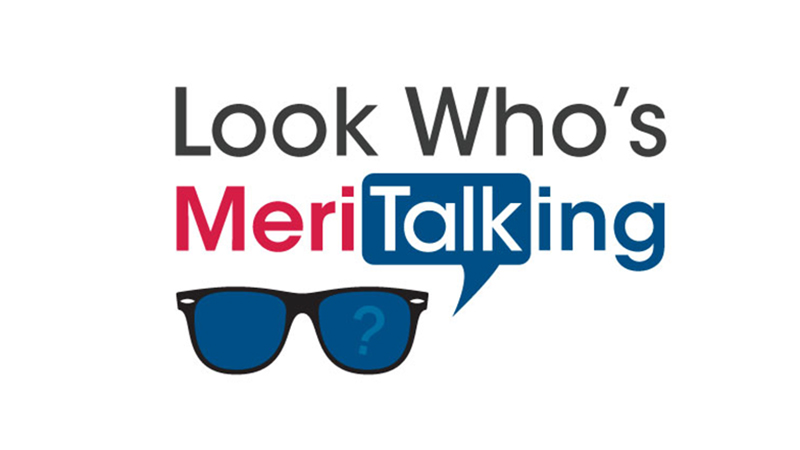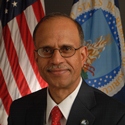Look Who’s MeriTalking: Michael Valivullah

Dr. Michael Valivullah is the CTO of the National Agricultural Statistics Service and the U.S. Department of Agriculture.
MeriTalk: What are you working on in terms of big data at NASS and USDA?

Michael Valivullah: My interest right now is in precision agriculture, and that brings in the big data effort to our agency. What we’re trying to do with NASS is to reduce respondent burdens, because we publish more than 400 reports every year. And we send out surveys, hundreds and hundreds of surveys to farmers, ranchers, producers, and farm businesses to create data. Our mission is to publish timely, accurate, and useful information to U.S. agriculture. We have over 500 statisticians, and all they do is crunch data all day. That’s what we do. So my interest in precision agriculture is because of the need.
Precision agriculture uses very sensitive sensors and gathers data to the very smallest level possible. The crops can be treated scientifically to decrease the amount of water, fertilizer, and chemicals used, and to increase the productivity of that particular patch of soil, using unmanned aerial systems and all kinds of onboard sensors.
My interest is that, because we are collecting the data, the number of people responding to our surveys has decreased. So we have this non-response challenge from the people who are supposed to provide us with data, and the quality of the data tends to be subjective. It takes time and money for us to do it, and we need to decrease the cost, because … we send people to these farmers and ranchers to collect data. So if we get the data directly from the sensors, with permission of course, we will be able to use the data directly and more objectively, while decreasing the data collection cost. The accuracy of that data will increase and the reporting cycle will decrease.
MeriTalk: Talk a little bit about big data. What are the opportunities and challenges?
MV: The challenge is the infrastructure to process the data. The other one is integration: How are you going to integrate the different types of data that are coming into the organization? Then people’s skills: It takes a different type of skill set to process this type of data, so usually organizations do not have the required skill set to do it well. They need to send people to training in some field that is new, and people just don’t know what process they should use or how to manage all this data.
The opportunities are immense, because big data can add trillions of dollars to GDPs according to several management and consulting companies. Meaning that there is so much value in data today, and people just don’t know about it. There are four different ways of looking at the data. One, you can use it to describe the information that you have, which is descriptive analytics. Then, if you don’t know the problem the data is showing, or you have some issue you want to identify, you can use diagnostic modeling analytics to see what is wrong and where. Then you can use it for predictive analytics; based on the data you have, you will be able to tell what the future is going to hold. Then you have prescriptive analytics; once you see what is wrong, you can define or write a prescription for it. For us, we will be able to predict crop estimations. What we do is, during the growing season, we estimate what the crop yield is going to be during the harvest season. That is going to help immensely, because now we are gathering the data manually and it’s subjective. Hopefully, big data will make our estimates closer to real yields when the harvest comes. Those are the benefits.
MeriTalk: How can one manage privacy and security in a big data world?
MV: That is a big challenge for us. There is a law called the Confidential Information Protection and Statistical Efficiency Act (CIPSEA), which says that we are, by law, required to safeguard the information we receive from farmers and ranchers. When we get this information, data such as their name and particulars related to their crop land, we publish and anonymize the data so that no farmer, rancher, or agricultural business will be identified. We need to protect the data, and security is a major concern for us. Security has three things in it: confidentiality, integrity, and availability. So we want to make sure that the data is confidential, has been integrated with integrity, has not been changed, and is available whenever it’s needed.
MeriTalk: What are some of the IT challenges that NASS or USDA face?
MV: As time goes by, we are getting less and less people interested in giving us the data. Non-response is the biggest issue we are facing, but also the cost of the data. Our budgets are getting cut, and we don’t have enough money to employ the required number of people to go get the data or have other systems in place to collect that information. It is a resource constraint like everybody else, and all the other agencies also have the same issue, because their budgets are getting cut. The only way that we can make do is to employ automated technologies or artificial intelligence to the point where this data can be collected by machines and not reduce manual and in-person data collections to reduce cost and time taken to collect data.
MeriTalk: How has cloud computing affected your agency and its plans?
MV: We have been very fortunate in having the first government cloud implemented a long time ago. USDA is one of the first Federal agencies that set up their own FedRAMP-certified cloud, and NASS was lucky enough to jump on that bandwagon. First, we rolled out our email on the private cloud, and we were able to save almost 60-65 percent on our email system, so it was a big cost saving. We have taken advantage of cloud computing, shared services, and reduced our footprint in terms of data centers. We went from 46 to 2 data centers. The cloud has been very good for NASS to hold all of the Federal data.
MeriTalk: How does your agency support mobility?
MV: NASS was the first agency to deploy iPads in the field, about four years ago. We’ve been out collecting data using iPads in the field and advancing in that area. We are rolling out more and more features, as we have iPads, iPhones, and now adaptive computing. Any particular endpoint can do the surveys, so we can send it to the farmers and they can do the surveys on their iPhone if they like. We’ve gone pretty far on that iPad rollout, and we will be able to implement that soon enough. We also implemented VDI, Virtual Desktop Infrastructure, about four years ago.
MeriTalk: For those that want to become a CTO, what advice do you have?
MV: First of all, as the name implies, they need to be very up-to-date with technology, what is happening in the industry, and have a good understanding of technology. Also, they need to understand how it relates to the mission of the agency. That is very important. As the leader, integrity is very important to this position, because anything that you say or do will be reflecting upon you and also the agency. And people skills, how to collaborate, how to work with other people, are important. The CTO is an advisory position, so you have to be a big thinker and have some conceptual, high level of thinking. Look at the future: how can you innovate; how can you learn from previous experience; how can the agency benefit from technology? The CTO’s job is to look at the future and move the agency forward with forward thinking.
MeriTalk: Finally, what do you look for in an IT leader?
MV: First of all I look at their background, their skills, their experiences, and their comfort level with technology. They should be confident learners. People need to have the mentality to learn; those are the folks who make good employees. I look for people who have the aptitude and the excitement to learn, because IT is constantly changing. As an IT employee, one needs to be able to learn all the time. I also look for working with other people and the ability to work as a team.
I am pretty satisfied with the role I am playing, have played all along, in working in different environments. Every time I go to a new place, I learn a lot, and that gets me excited and motivated. Technology is constantly changing, and I am a learner; I like to learn new things and try new things and do new things. That works for me very well.
